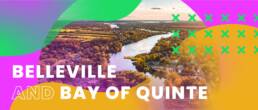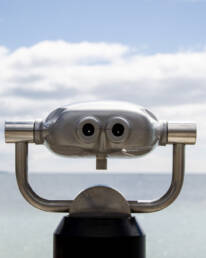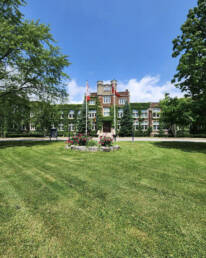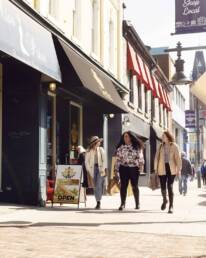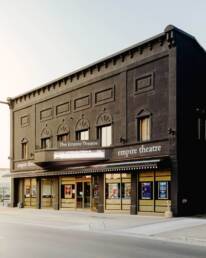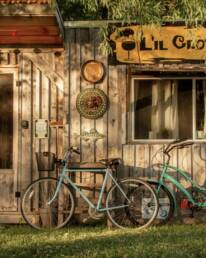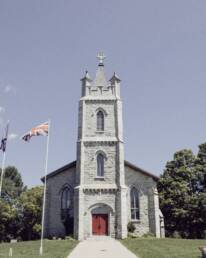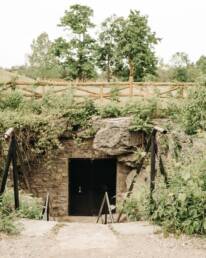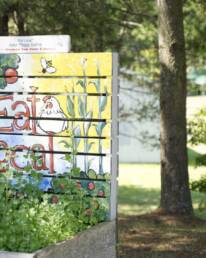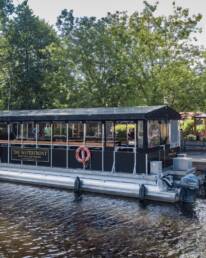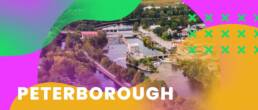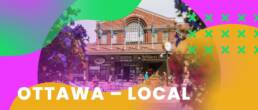Belleville and Bay of Quinte
September 9, 2022 | Photo Credit Justen Soule
Belleville and Bay of Quinte
Its official name isn’t the Beautiful Bay of Quinte but it could be — given the undeniable charms of what locals just call the Bay. As a newer travel destination, it has a very old history — back in the 12th century it was the birthplace of Tekanawita (the Peacemaker) who brought a constitution of peace to the original Five Nations Iroquois Confederacy. Today, the Bay of Quinte is fast becoming known for arts and culture (not to mention plenty of good eats).
Day One
MORNINGPRESQU’ILE PARK
FROM SHOREBIRDS TO SONGBIRDS
Birding is really taking off (pun intended!) as one of the fastest-growing hobbies in North America. Presqu’ile Park, a hot spot for bird migration with some 338 species identified, is a perfect vantage point to admire both shorebirds and songbirds. With its long sandy beach and Lake Ontario views the park is also ideal for walking, biking and camping. (The marsh boardwalk has been called “a gem” by more than one visitor.) To learn about the area’s natural and cultural history, stop in at both The Nature Centre and The Lighthouse Interpretive Centre, which highlights the park’s cultural legacy and its connection to Lake Ontario’s past.
MORNINGMEANDER ALONG THE BAY TO BELLEVILLE
FROM FLYING MACHINES TO FESTIVALS
While road tripping from Brighton to Belleville, take the opportunity to make a few stops along the way. In Trenton, visit the National Air Force Museum, which explores the country’s aviation history and features a sixteen-acre air park dedicated to flying machines (past and present). For nature enthusiasts, there is the Potter Creek Conservation Area, conveniently located off HWY 2, just as you approach Belleville
To learn about Deaf history, visit the Sir James Whitney School for the Deaf, which recently celebrated its 150-year anniversary. Explore their new Archives & Museum by booking an appointment or simply appreciate the heritage plaque on the picturesque grounds.
Another worthwhile stop is West Zwick’s Island Park on the Waterfront near the Belleville Bay Bridge, where you may often find pop-ups and festivals happening.
AFTERNOONDOWNTOWN BELLEVILLE
HISTORIC CHARM; CONTEMPORARY COOL
Sitting pretty on the Bay and the banks of the Moira, downtown Belleville is a rare find: equal parts historic charm and contemporary cool.
Pop in and out of galleries, including Belleville Art Association and Gallery 121 featuring local artists or the John M. Parrott Gallery in the Belleville Public Library. While exploring some of the many boutiques, keep your eyes open for public art too, notably local artist Chris Bennett’s colourful murals adorning a number of establishments.
A short walk (or three-minute drive) east lands you in the Old East Hill Neighbourhood. Belleville’s historic architecture provides an elegant backdrop for wandering from historic buildings like Bellevue Terrace, to Glanmore National Historic Site. The historic homes in the area date back to the 1800’s, and are the perfect setting for Belleville’s annual September Porchfest – a free, family-friendly music festival which sees thousands of attendees enjoying music played from porches, hosted by the local Rotary Club of Belleville.
EVENINGTHE EMPIRE AND MORE
DINNER, THEN A SHOW
Before enjoying a show later in the evening, make your way back to downtown Belleville to indulge in a delicious meal. If you’re craving Mexican cuisine, Chilangos is a must-visit culinary destination in Belleville. Another fantastic option in the downtown area is The Lark, a charming and modern restaurant known for its intimate ambiance and imaginative cocktails.
For a small place, Belleville sure loves its theatre – so you have a lot to choose from. There’s The Empire, a vintage 1938 theatre presenting indie films and live performances (including some of Canada’s biggest name artists). There’s River & Main Theatre Co. (at the intimate storefront Theatre in the Wings). And there’s the Belleville Theatre Guild (top notch community theatre for over seventy years). Oh, and if for some reason you’re heading back west, note that actors also tread the boards at the City of Quinte’s Old Church Theatre and the Brighton Barn Theatre.
Day Two
MORNINGTYENDINAGA MOHAWK TERRITORY
DISTINCTIVE INDIGENOUS ARTS AND CRAFTS
You’ll know you’ve arrived when you start seeing Mohawk language on street signs and buildings. Tyendinaga Mohawk Territory was established in 1784, a forced relocation leading to the loss of ancestral homelands. (Visit the Mohawk Landing on Bayshore Road to learn more.) Among the traditions of Kanienʼkehá꞉ka (Mohawk) people is distinctive original artwork and crafts. Make sure to stop at Native Renaissance, featuring emerging and well-known Indigenous artists, notably Thomas B. Maracle whose stone, wood and corn husk creations are prized internationally. Other must-stops include Rebecca Maracle’s Gallery & Gifts, showcasing exquisite feather art; Soaring Eagle Native Arts & Crafts for meticulously handcrafted work with all-natural materials, and Eagle POD Gallery, with its striking, one-of-a-kind sculptures by David R. Maracle. After this feast for the eyes, you may want a feast for the stomach: you’ll find fresh walleye at many local restaurants.
AFTERNOONHER MAJESTY’S ROYAL CHAPEL OF THE MOHAWKS
HISTORY AT THE CHAPEL
Mohawks were military allies of the British Crown during the American Revolution and part of that legacy is embodied by the chapel at Christ Church. It’s one of a small number of royal chapels outside of Great Britain and is of historic significance to both the Indigenous and colonial history of Turtle Island/Canada. The church itself, welcoming both Indigenous and non-Indigenous worshippers, was built by Mohawks and contains a triptych in the Mohawk language. Outside of Sunday services hours are variable, but it’s worth stopping by just to gaze at the 19th century Gothic revival style architecture.
AFTERNOONTYENDINAGA CAVERN AND CAVES
AN UNDERGROUND ADVENTURE
Fantastic fossils, cool depths, and a resident ghost: all of the above are found below! Meaning in the caves, which date back thousands of years. Geology lovers should get excited – the fossils found here connect sightseers to the extensive history of this natural wonder. Considered an easy and accessible adventure (at a small enough scale that even littles can enjoy), the Tyendinaga Cavern and Caves are also about ethical and sustainable tourism that gives curious visitors a chance to learn something of the local history and geology.
AFTERNOONGREATER NAPANEE ‘PALLET’ABLE ART PROJECT
ART ON THE SKIDS
As you follow the scenic route along the Bay of Quinte and up the Napanee River, you will reach the charming Town of Greater Napanee. One of the notable attractions in the town is the ‘Pallet’able Art Project, public art literally created on wooden industrial skids and pallets. Twenty-some charming original works dot the city, making splashes of bright, eye-catching colour. Navigate your way from pallet to pallet via Greater Napanee’s handy online map. (You may want to incorporate a little local history too, via the town’s historic walking tour map.)
EVENINGMUSIC
PINTS, PUBS, MUSIC
Start your evening relaxing at one of Greater Napanee’s favourite spots, for instance by having a brew at the wee patio of multiple-award-winning Napanee Beer Company. Another option, the (similarly award-winning) Waterfront River Pub and Terrace, located right on the Napanee. (Trivia note: the Napanee River is known for having its own “seiche,” a tidal effect due in part to the strong winds on Lake Ontario’s north shore.) The Waterfront often features local musicians, and for national talent check out the Starstop Concert Series, designed to catch top Canadian talent crossing the country on tour. One final music note: for concerts beneath the skies (and by the river), on a summer afternoon watch for the Music by the River series in lovely Conservation Park.
YOUR TRIP AT A GLANCE
SEE
Bay of Quinte
Belleville Art Association
Belleville Theatre Guild
Brighton Barn Theatre
Chris Bennett’s murals
City of Quinte’s Old Church Theatre
Eagle POD Gallery
The Empire
Gallery 121
Her Majesty’s Royal Chapel of the Mohawks
John M. Parrott Gallery in the Belleville Public Library
The Lighthouse Interpretive Centre
Music by the River
The National Air Force Museum of Canada
The Nature Centre
The ‘Pallet’able Art Project
Porchfest
Quinte Arts Council
River & Main Theatre Co.
Starstop Concert Series
Tyendinaga Cavern and Caves
NEED A MAP?
This guide represents a weekend-long experience, highlighting one of the many wonderful destinations in the area. To suggest a destination for a future guide, please contact us.
All editorial decisions were made at the sole discretion of Ontario Culture Days staff. This guide was written by Li Robbins.
Peterborough
Photo courtesy of Destination Ontario.
Peterborough
Peterborough is built on the shores of the Otonabee River, first known as Nogojiwanong, which is Ojibwa for “place at the end of rapids.” The Otonabee (or Odenabe, “river that beats like a heart”) isn’t the only waterway to criss-cross the city: a canal (part of the Trent-Severn Waterway) and a creek (Jackson) also run through it. So, Peterborough’s culture is intrinsically linked to this unique and striking setting.
Day One
MORNINGTHE CANADIAN CANOE MUSEUM
A CANOE ON EVERY CORNER
You know you’re in Peterborough when you spot a canoe on practically every corner. Some are land-bound, like the art installation Jiimaan’ndewemgadnong — The Place Where the Heart of the Canoe Beats, at the corner of King and Water Streets, by Anishinaabe artist Tia Cavanagh.
But there’s no better place to understand the canoe’s significance than the Canadian Canoe Museum. It’s the world’s largest collection of paddled crafts, filled with stunning, historic canoes and kayaks. The collection spans from the First Nations of the Pacific Northwest’s huge dugouts to bark canoes of Newfoundland’s Beothuk. In 2023 the museum is poised to expand in a new location and building on the water, with more exhibits to reflect its collaborative relationships between Indigenous and non-Indigenous peoples.
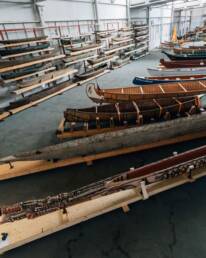
AFTERNOONHUNTER STREET CAFÉ DISTRICT
THE CAFÉ LIFE, PETERBOROUGH STYLE
Peterborough is a smallish city, with a population of 84,000 and change. But it boasts a vibrant café district along Hunter Street West. A couple of attractive blocks of bars, cafés and boutiques, it includes The Only Café, perched on the edge of Jackson Creek. The Only is an institution known for excellent sandwiches, eclectic décor, and as a favourite hang for everyone from students to politicians. Another long-running favourite is Black Honey Bakery — a homey, cozy café with tasty brunches and vegan options. On the shopping front, head to Hunter and George Streets for hip fashions (S.O.S.), locally-branded “Ptbo Northern Originals” wear (Flavour), or handcrafted jewelry and gifts (Hi Ho Silver).
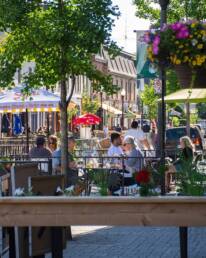
AFTERNOONHUTCHISON HOUSE
SEE HOW THE SETTLERS LIVED
Step back in time at Hutchison House, a short walk from Hunter Street. Locals built the home in 1837 to entice Peterborough’s first resident physician, Dr. John Hutchison, to stick around – they were successful. Now it sits filled with medical instruments, books and furnishings of the time. The museum also has memorabilia belonging to the good doctor’s cousin, Sir Sandford Fleming, famed engineer, scientist and inventor. Fleming’s design for a forerunner of the roller blade is one of the many charming artifacts on display. In summer, take tea on the terrace; in winter, sip beside the open hearth in the Hutchison House kitchen.
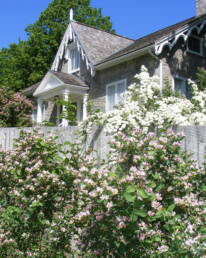
AFTERNOONLIFT LOCK
THE WORLD’S TALLEST BOAT LIFTER
A marvel of engineering, the Lift Lock its the highest hydraulic lift lock in the world and is designed to lift boats nearly twenty metres. The Lift Lock Visitor Centre explains how that’s done, as well as answers all your Trent-Severn Waterway questions (the 386-kilometre-long canal that connects Lake Ontario to Georgian Bay).
Want to get inside the Lift Lock? A Lift Lock Riverboat cruise gives you a boat’s-eye-view. Or, for the jaw-dropping experience, bring your own kayak or canoe to join in on the annual Lock ‘n’ Paddle.
In winter, skate the canal beneath the mighty lock. In summer, picnic on canal banks.
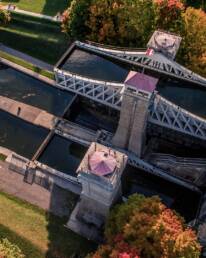
AFTERNOONART GALLERY OF PETERBOROUGH
CONTEMPORARY ART ON THE (LITTLE) LAKE
Located south of downtown on Little Lake, the AGP is a little gem of contemporary art. Its permanent collection includes work by significant regional Indigenous artists (Mary Anne Barkhouse, Michael Belmore), as well as artists from further afield (Daphne Odjig, Carl Beam, Jane Ash Poitras, and Rebecca Belmore). While you’re there, drop into the Gallery Shop for regional one-of-a-kind arts and crafts, and fun stuff for kids too. For a restful summer afternoon stop, don’t miss ice cream by the river at the cottage-like Silver Bean, just a 10-minute walk north of the gallery.
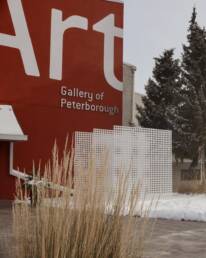
EVENINGCULINARY PETERBOROUGH
WINE, DINE, AND STROLL THE OTONABEE
Excellence and diversity are markers of the city’s culinary strengths, for instance La Hacienda’s Mexican cuisine (and adjacent mercado), Hanoi House’s Vietnamese food (and oysters) and Fresh Dreams (traditional Spanish Tapas). All are located in and around Hunter Street West, not far from the beautifully landscaped Millennium Park trail. A post-dinner easy stroll along the Otonabee includes sculptures and a display tracing the city’s Indigenous and colonization history.
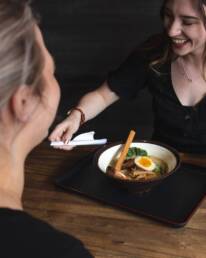
EVENINGLIVE MUSIC
FROM THE BLACK HORSE TO THE RED DOG — CATCH SOME TUNES
Peterborough is a music-loving town, and two venerable establishments are The Black Horse (jazz and blues) and the Historic Red Dog Tavern (reggae, rock, and hip hop). Yes, “historic” is part of the official name, opening as a hotel in 1883, and going on to become known as “the home of live music.” Many a legendary musician (Neil Young, Ronnie Hawkins, Jeff Healey) have played the Red Dog, a tradition continuing today with both nationally-known and rising-star local acts.
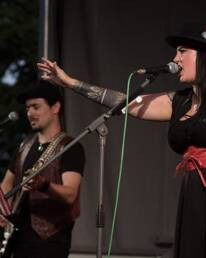
Day Two
MORNINGNOGOJIWANONG TO PETERBOROUGH (AND BACK AGAIN)
AUTHENTIC CONNECTION TO LAND, WATER AND PEOPLE
Peterborough is known by many names: The ‘Boro, The Patch, Ptbo, Electric City, and increasingly by its original Ojibwe name, Nogojiwanong. For a deeper understanding of this Indigenous culture, take the 30-minute drive north to Curve Lake First Nation. Along your way, enjoy the scenic river views for most of your drive.
There you’ll find both the Whetung Ojibwa Centre and Curve Lake Cultural Centre. The Curve Lake Cultural Centre is dedicated to keeping traditions and ceremonies alive within the community. Immerse yourself in the history and culture of the people, the Michi Saagiig Anishnaabeg, and learn about their language, geography, history, and traditions.
Two minutes down the same road, the Whetung Ojibwa Centre offers a spectacular collection of Native crafts and fine art from both Curve Lake First Nation and across Canada. In addition to the shop, there is also a museum with totem poles, headdresses, moccasins, dreamcatchers and more, all within a 10,000 sq ft building. This centre is open seven days a week, and if you are in the area at the end of summer, you are welcome to attend the annual Pow Wow.
AFTERNOONLAKEFIELD
TAKE THE SCENIC RIVER ROAD TO LAKEFIELD
Peterborough has enviable proximity to lovely lakes and charming towns. Lakefield combines both, just south of Katchewanooka Lake and right on the Otonabee. A twenty-minute drive along the winding Water Street from downtown brings you past Trent University and into picturesque Lakefield. The town’s literary history (authors Susanna Moodie, Catherine Parr Traill, and Margaret Lawrence all made their homes there) makes it the logical place for July’s annual Lakefield Literary Festival. (Resuming in 2023.) Shop Queen St., or make it your dinner stop. A few popular spots: Canoe & Paddle pub, Cassis Bistro (fine dining), and The Nutty Bean, boasting “the best verandah” in town.
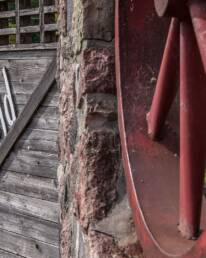
AFTERNOONPETERBOROUGH MUSEUM AND ARCHIVES
TAKE THE SCENIC RIVER ROAD TO LAKEFIELD
Finally reaching the north end of Peterborough on your drive back in, you’ll find the family-friendly Peterborough Museum and Archives tells the local story. From early Indigenous communities and the first wave of Irish immigration, and the city’s rise and fall as an industrial town and beyond, their collection speaks of it all.
For an early dinner, wander around the East City. One choice spot: Ashburnham Ale House for local beers and high-end pub grub.
AFTERNOONJACKSON PARK
FOREST IN THE CITY — A CULTURAL HERITAGE LANDSCAPE
Jackson Park is one of a handful of Ontario parks with old-growth forest, and also a recently designated cultural heritage landscape. Yet it’s only a five-minute drive from Hutchison House. Stroll around the pond, a favourite spot for waterfowl and those wishing to photograph them. Pause on the restored, 1894 pagoda bridge. Or enjoy the 4.2 kilometre Jackson Creek trail, its rushing waters your soundtrack for walking, biking, or cross country skiing — Peterborough Nordic Club maintains classic ski tracks. Omemee (songwriter Neil Young’s hometown) is also a favourite cycling destination, the 44 kilometre round trip taking you over Doube’s Trestle Bridge with spectacular views of Buttermilk Valley.
EVENINGMARKET HALL PERFORMING ARTS CENTRE
TO MARKET FOR MUSIC, OR THEATRE, OR DANCE
Located beneath Peterborough’s landmark clock tower, Market Hall is known for its theatrical and musical presentations, though it’s also a vibrant community centre, featuring political debates and more. Spacious yet still intimate, it’s come a long way since its 19th century days as a food market. Enjoy a show while testing out the local theory: the beautifully restored Market Hall hasn’t got a bad seat in the house.
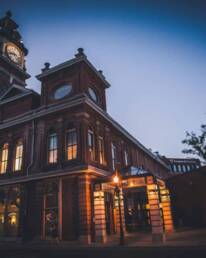
WANT TO TAKE A DETOUR?
WARSAW CAVES CONSERVATION AREA
The Warsaw Caves Conservation Area (a twenty-minute drive from Lakefield) will satisfy almost any outdoor itch you want to scratch, with scenic hiking trails, camping, and paddling, fishing or swimming on the Indian River. You can even go spelunking in the seven namesake caves, which were formed at the end of the last ice age.
YOUR TRIP AT A GLANCE
SEE
Art Gallery of Peterborough
Art Space
The Canadian Canoe Museum
Hutchison House
Jackson Creek trail
Lakefield Literary Festival
Lift Lock Visitor Centre
Market Hall Performing Arts Centre
Peterborough Museum and Archives
Showplace Performance Centre
Trent University
Warsaw Caves Conservation Area
Whetung Gallery
NEED A MAP?
This guide represents a weekend-long experience, highlighting one of the many wonderful destinations in the area. To suggest a destination for a future guide, please contact us.
All editorial decisions were made at the sole discretion of Ontario Culture Days staff. This guide was written by Li Robbins.
Ottawa – Local
Updated November 2022 | Photo credit: © Destination Ontario
Ottawa – Local
The nation’s capital is known for its impressive “big-ticket” possibilities: Parliament Hill, international festivals, nationally significant museums, and the world’s longest skating rink and largest Tulip Festival. But for millennia before French explorers arrived, Indigenous Peoples were living and trading in the region. Their history is everywhere, emerging more each day, and you can hear it in the language: the Algonquins called the region “Odawa”, where Ottawa’s name comes from, meaning “traders.” So, beyond those big-ticket possibilities, visit for a rich cultural experience, a palette of diverse cuisine, and creativity from all corners of the nation’s capital.
Day One
MORNINGTWO FARMS, TWO WAYS: THE EXPERIMENTAL FARM AND MĀDAHÒKÌ FARMS
INDIGENOUS PERSPECTIVES, INDUSTRY AND SPIRIT HORSES
Mādahòkì Farm builds on the growing interest in agritourism in Ottawa’s Greenbelt, including farm-to-table culinary experiences and authentic cultural experiences from an Indigenous perspective. The Farm hosts a series of Indigenous events celebrating the seasons: Sīgwan (Spring), Tagwàgi (Autumn) and Pibòn (Winter) and the annual Summer Solstice Indigenous Festival. Year-round, the Farm is also the home of an Indigenous Marketplace and five endangered Ojibwe Spirit Horses.
A WALK ON A WORKING FARM… IN THE CITY
In our changing industrial world, farms and cities are trying to strike a new balance with each other. The Central Experimental Farm is a few kilometres from downtown. But it’s no hobby farm, not at 426 hectares. Established in 1886, the farm has made significant contributions to Canadian agriculture, like developing the world-famous, frost-resistant Marquis wheat. When you visit, deep dive into our nation’s agricultural heritage at the Canadian Agricultural and Food Museum. Or, just talk to the animals: the museum is home to cows, alpacas, pigs, horses, goats and more.
At the Experimental Farm, wend your way along winding paths reminiscent of a British country estate: swathes of lawn, ornamental gardens, an arboretum with some trees planted back in 1889. Along the path, catch the distinctly Canadian sight of the Rideau Canal and Dow’s Lake. An Experimental Farm visit is a unique experience, literally: it’s the world’s only working farm in the heart of a capital city.
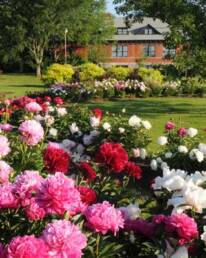
AFTERNOONHAPPENING HINTONBURG
QUIRKY AND CUTE: WELLINGTON WEST’S HINTONBURG
Bustling, artsy, trendy, eclectic, cool: just some of the descriptors of Wellington West, on your drive back in from the farms. East of Holland Avenue, it’s Hintonburg, with great specialty stores — a far cry from the rail yards, lumber and paper mills of its 19th century days. Same with the neighborhood’s designation as the QUAD (Quartier des artistes/Arts District), as Hintonburg is home to galleries, studios, and art-friendly restaurants.
As to those specialty stores: they are thinking local and sustainable. Terra20 sells cruelty-free, non-toxic and ethically sourced products. At Nu Grocery, Ottawa’s first zero-waste grocery store, you’ll find everything from cereals to toothpaste. Drop by the Maker House Co. for handmade homewares created by Ottawa artisans. Don’t forget music: The Record Centre, purveyors of new and used vinyl (and turntables), has also been known for local band performances.
Need a sip and snack break? Try one of the wonderfully named local chains: the Ministry of Coffee and Social Affairs, or Happy Goat Coffee.
AFTERNOONFASHION AND FOOD
GO WEST TO WELLINGTON VILLAGE
Go west (of Holland Ave.) to Wellington Village for a myriad of possibilities from Canadian independent designers. It’s all about boutiques. Kindred Shop and Studio’s ethically made clothing and made-in-Ottawa gifts; Flock’s handmade, local, sustainable wares; JV Studios & Boutique’s emerging Ottawa brands; Victoire Boutique’s “smitten with Canadian design” approach and more. For a break from shopping, head to the NAK Gallery, opened in 2020 to showcase contemporary visual art.
The Village is also a great spot for a leisurely dinner, with its nearly two dozen restaurants. Just a few possibilities include contemporary Canadian cuisine at Stofa; locally sourced fare at Supply and Demand; or upscale pub food at Wellington Gastropub. (Locals call it The Wellie.) Speaking of pubs, Ottawa craft beer is a growing concern. If it’s of concern to you, consider a Brew Donkey “curated regional adult field trip” to local breweries.
For a quick bite, try Beandigen Cafe, an Anishinaabe owned and operated cafe on the unceded territory of the Algonquin Anishinaabe. Located in the heart of the city at Ottawa’s Lansdowne Park, the café offers coffee, espresso, and light snacks as well as retail space to connect and purchase Indigenous goods, art and crafts from local Indigenous artists. Beandigen is a play on words from the term “welcome” in Anishinaabemowin (Ojibway), which inspired the name and feel of the cafe.”

EVENINGTAKE IN A SHOW
IT’S GREAT, IT’S CANADIAN, IT’S THEATRE
The Great Canadian Theatre Company, or GCTC, as Ottawans call it, is located almost in the centre of Wellington West. It’s also at the centre of the local theatre scene. The city’s largest professional, independent theatre was born in 1975 when Carleton University profs and grad students decided to produce Canadian plays. After two decades of treading the boards in a renovated truck garage the GCTC moved to Wellington West. Now they showcase plays and theatre events at the Irving Greenberg Theatre Centre, with its 262-seat mainstage space. Bonus: Spacious lobbies and a studio theatre make GCTC a hub for community events.
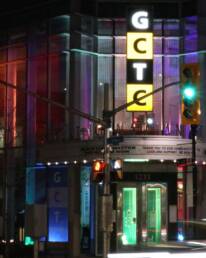
Day Two
MORNINGA NEIGHBOURHOOD WANDER
STROLL THE STREETS OF HISTORIC SANDY HILL
The sandy soil of this slightly-off-the-beaten-track residential neighborhood means you won’t see many tall buildings. But you will see dignified embassies and gracious apartment buildings (circa 1860 to the 1920s). Two of Canada’s most important prime ministers (Sir Wilfrid Laurier and the Rt. Hon. William Lyon Mackenzie King) lived in Sandy Hill. At some times of year you can visit their former home of Laurier House, a Second Empire mansion. Today, Sandy Hill is where affluence meets student living, with bars, brewpubs and coffee shops around the U. of O. Students, locals and tourists alike can enjoy cuisine from around the world, including India, Thailand, Mexico, Japan and Middle East. For a river walk, stroll Strathcona park along the Rideau, where in summertime you can enjoy theatre under the stars.
AFTERNOONSAW GALLERY
VISIT ONE OF CANADA’S LEADING ARTIST-RUN CENTRES
Stop at the SAW Gallery on your way to the market. The artist-run centre is famed for politically and socially engaged artwork and performances. Lured by the North? Check out SAW’s recently opened Nordic Lab with the Annie Pootoogook Studio, named for the celebrated Inuit artist. Take in a community event (from screenings to concerts to artist talks) at Club SAW, complete with bar and state-of-the-art sound system.

AFTERNOONGO TO MARKET
MAKE BYWARD MARKET YOUR ART WALK
ByWard Market is just a stone’s throw from SAW and a perfect place for a café lunch. Pick from a variety of cuisines, including Island Flava, Island Grill, Ocho Rios Caribbean Eatery, Sweetgrass Aboriginal Bistro. And, of course, for the sweet stuff, a.k.a. Beavertails. (Deep fried pastry and sugar. Say no more.) Lieutenant-Colonel John By drained a cedar bog and made a market here in 1827 so the families of workers building the Rideau Canal had a place to shop. Almost two centuries later the market still draws locals for great foodstuffs.
But it’s also a cultural draw. Follow the ByWard Market Art Walk map for stunning murals. The Art Walk includes murals by diverse artists, including Black and Indigenous muralists. Then drop by the Ottawa School of Art for contemporary art exhibits and to browse the boutique for paintings, jewelry and sculpture. All of it Canadian; much of it local.
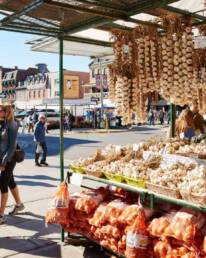
EVENINGBYWARD BY NIGHT
THE MARKET BY NIGHT: DRINKS, DINNER AND BEATS
There’s no shortage of nightlife in the market. Try the storied Chateau Lafayette, a.k.a. The Laff, Ottawa’s oldest tavern since 1849. Or go upscale with Copper Spirits and Sights Rooftop Lounge, for Canadian-inspired cuisine and craft cocktails. (It’s a great sunset spot with a prime view of Parliament Hill.) For late nights drop by the Mercury Lounge, the “twenty-first century soul club” where beats-meets-jazz. Come for drag shows, or to enjoy soca, rap, and rock music. The intimate Mercury has brought music, poetry readings and dance performances to Ottawans for over twenty years.
YOUR TRIP AT A GLANCE
YOUR TRIP AT A GLANCE
This guide represents a weekend-long experience, highlighting one of the many wonderful destinations in the area. To suggest a destination for a future guide, please contact us.
All editorial decisions were made at the sole discretion of Ontario Culture Days staff. This guide was written by Li Robbins.
Prince Edward County
Prince Edward County
Prince Edward County has been called “Canada’s coolest Island hideout,” a place where “hip meets historic.” (By Condé Naste Traveller and The New York Times, respectively.) The County, as it’s known, is a world-renowned destination for its stunning beaches, charming towns, and exceptional food and wine. At two hours from Toronto it’s no surprise it’s such a popular destination.
Day One
MORNINGVISIT AMELIASBURGH
DAY 1 — 10:00 AM: PIONEERS, POETS, AND PERENNIALS — BEGIN YOUR COUNTY VISIT IN AMELIASBURGH
Long before European settlers arrived, Carrying Place was a meeting point for Anishnaabeg, Wendat and Haudenosaunee peoples — and a link between the Bay of Quinte and Lake Ontario. Today, Carrying Place is still a gateway to the island. And it’s just a short drive (not much in The County is a long drive) to the Ameliasburgh Heritage Village. Founded in 1968 in a former Wesleyan Methodist Church, it’s now a full pioneer village, including a blacksmith shop and a beekeeping building. (Do double check the Ameliasburgh Heritage Village website for opening times before going.)
If you’re a fan of poetry, note that famed Canadian poet Al Purdy lived on nearby Roblin Lake for many years. The Ameliasburgh Library has a collection of Purdy memorabilia.
Next, a fifteen-minute hop by car takes you to Oeno Gallery’s Sculpture Garden at Huff Estates Winery. There you’ll discover how art created by nature (think: perennials) can have a unique relationship with art created by human (think: glass, bronze, wood). And, since you’re already there, enjoy the scenery at Huff Estates Inn & Winery.
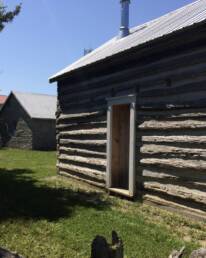
AFTERNOONEXPLORE QUAINT WELLINGTON
DAY 1 — 1:00 PM: REVEL IN WELLINGTON’S MANY CHARMS
It’s challenging to mention Wellington without using the word “quaint,” since the community is the site of some of Ontario’s oldest homes and finest architecture, including a house dating back to 1786. Wellington’s also at the heart of this region’s wine country, making it a perfect jumping off point for winery visits. But first, lunch! With cool lake breezes Wellington’s an ideal lunch stop — the only question being what to choose. La Condesa for tacos? Midtown Brewing Co for tasty light bites? Boutique hotel/restaurant/bar the Drake Devonshire for something upscale? Whatever you decide, a stroll along the beach boardwalk after lunch is in order. Or, peruse galleries on Main Street, for instance SideStreet Gallery, featuring local artisans, or the Sybil Frank Gallery, specializing in fine art.
Keep an eye out for green bicycles — they mark the home studios of glass blowers, potters etc. Of course, art is everywhere in The County, as the year-round Prince Edward County Arts Trail shows. It winds in and around Wellington, Bloomfield, and Picton, connecting arts lovers, buyers, and collectors with professional galleries and studios.

AFTERNOONENJOY LOCAL WINERIES
DAY 1 — 3:00 PM: SERIOUS ABOUT WINE, BUT REFRESHINGLY UNPRETENTIOUS
The County’s over forty wineries are known for being serious about wine while having “refreshingly unpretentious” wine tastings. They feature wines with a distinctive sense of place, due to the porous limestone-rich soil of The County. Local specialties include Pinot Noir and Chardonnay; adventure is also the name of the game with innovative Rieslings, Baco Noirs, Pinot Gris…the list goes on.
You’ll find a number of tempting wineries close to Hillier, a little hamlet with a vibrant arts community. (Home to Alchemy, an artist residency focused on community engagement through art, food and conversation.) There’s family-run Broken Stone Winery, priding themselves in “hand-crafted wines, grown by our family for you.” There’s Closson Chase, a winery that helped spearhead the birth of The County wine industry, and an early advocate for sustainable practices. There’s Stanners Vineyard, dedicated to producing premium Pinot Noir.
But don’t neglect The County’s cideries! For instance, the award-winning Loch Mor Cider Co. They specialize in traditional, European-style dry ciders in a lovely pastoral setting. (It must be said, “lovely pastoral settings” define much of Prince Edward County.)
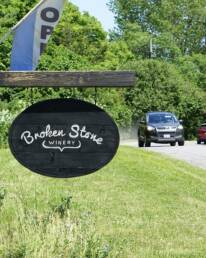
Day Two
MORNINGWANDER LOVELY LAVENDER FIELDS
DAY 2 — 11:00 AM: A CONTEMPLATIVE START AMIDST LAVENDER…OR ALPACAS
For a tranquil start to the day, surround yourself by fields of fragrant flowers at Millefleurs, a lavender and honey farm noted for its mead, a delightful sipping wine. The farm’s boutique brims over with lavender products, and honey and mead made on the farm.
If you’re still on a quest for comfort, swing by Chetwyn Farms, fifty-five acres devoted to Alpacas. The SHED at Chetwyn is a modern-day farm shop specializing in alpaca products. Watch the adorable woolly ones graze as you consider your cozy throw options. Or, head to nearby Noble Beast Farms to get up close and personal with the gentle creatures on an Alpaca trek.
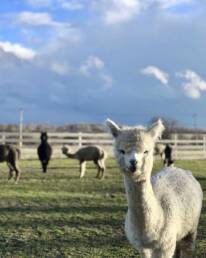
AFTERNOONHIT THE TRAIL
Day 2 — 1:00 PM: WALK OR RIDE THE MILLENNIUM TRAIL — NATURE, ART (AND PUBS!)
If it’s time for something more vigorous, take a hike or bike along The Millennium Trail. It’s 46-kilometres long, stretching from Carrying Place to Picton, The County’s central hub (itself chockablock with art galleries and restaurants). The trail wends its way through wine country with many fine restaurants, breweries and pubs en route. Built on a former rail line, it’s an easy (read: flat) walk or ride, complete with stunning scenery.
Take time for the arts in Bloomfield, where you’ll find the Hatch Gallery, featuring work by some of Canada’s finest contemporary artists, and the Baxter Arts Centre, a creative space for making art. (While in Bloomfield you may also want to wander down Barker Lane to visit Matron Fine Beer, surrounded by rural beauty.)
If you haven’t come prepared with your own two-wheeler, bikes are rentable at various locations including Wellington-based Ideal Bike, Bloomfield Bicycle Company, Pedego Electric Bikes and County Bike Rentals, among others.
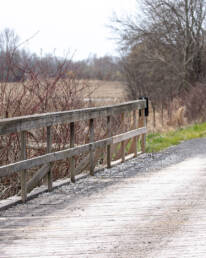
AFTERNOONMARVEL AT THE BEAUTIFUL SANDBANKS
DAY 2 — 3:00 PM: SOME OF THE BEST BEACHES IN CANADA ARE AT SANDBANKS
No itinerary of The County would be complete without mentioning Sandbanks Provincial Park, a 20-odd minute drive from Wellington. Sandbanks is home to the world’s largest baymouth barrier dune formation, with 12 kilometres of magnificent dunes formed by glaciers 12,500 years ago. White sand, turquoise water, and three beautiful beaches. Need we say more?
Sandbanks also provides an opportunity to learn about dune and wetland habitats on its walking trails. And, if you’re visiting in spring or fall you’re in for an avian treat as The County can be a good vantage point for a spectacular number of migratory birds. (Consider a visit to the Prince Edward Point Bird Observatory on the island’s southeast tip to learn more.)
Nature’s not the only art form in the Sandbanks area — a seven minute drive east and you’re at Mad Dog Gallery, located in a renovated century timber frame barn. There you’ll see the work of local artists, many of whom create works connected to County life. (For instance Andrew King, whose art celebrates local lighthouses and maritime history.)
Sandbanks is, understandably, a very popular destination, so make sure to buy a daily vehicle permit in advance to guarantee your spot. But don’t forget, there’s always more to explore on the island, with its nine distinct regions, 800 kilometres of shoreline, vast farmland, and abundance of charming towns.
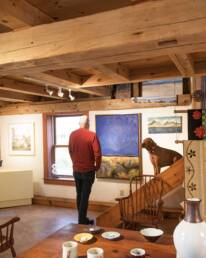
WANT TO TAKE A DETOUR?
Take the road less travelled with these stellar possibilities south of Picton:
- Macaulay Heritage Park takes you back to the 19th century. Stroll the Heritage Gardens; visit the former Church of St. Mary Magdalene, now a museum featuring a permanent exhibit dedicated to the County’s Indigenous history.
- Check out the whimsical Birdhouse City, a miniature community replicating historic County buildings as birdhouses.
Melt Studio and Gallery is run by encaustic (hot wax) artist Susan Wallis, and features the PAUSE experience — a forest bath and encaustic collaging guided by the artist. - For tasty artisanal cheeses it’s Black River Cheese, nestled on the banks of the river. Two special farms are in the vicinity: Quinta do Conde, with seasonal hyper-local dinners, and Morrison Point Farm with beautiful, historic stone fences (and small batch honey). Arts abound in and near Black River, with local artists’ studios and Black River Ridge, a summer art camp.
- Milford, self-proclaimed “hamlet of friendliness,” boasts three wineries (Lighthall Vineyards, Exultet Estates and Long Dog Winery), plus PECish Baking Company and a sustainably-run flower farm, FloraLora Flowers. Don’t miss Curious Goat General Store with its Bee & Blooms experience — an immersive adventure for the bee-curious.
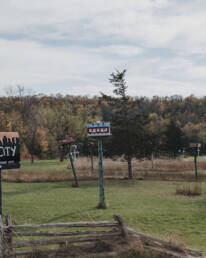
YOUR TRIP AT A GLANCE
SEE
Alchemy Artists Residency
Ameliasburgh Heritage Village
Ameliasburgh Library
Baxter Arts Centre
Birdhouse City
Black River Ridge
Chetwyn Farms
Curious Goat General Store
FloraLora Flowers
Hatch Gallery
Macaulay Heritage Park
Mad Dog Gallery
Melt Studio and Gallery
Millefleurs
The Millennium Trail
Noble Beast Farms
Oeno Gallery’s Sculpture Garden at Huff Estates Winery
Prince Edward County Arts Trail
Sandbanks Provincial Park
SideStreet Gallery
Sybil Frank Gallery
YOUR TRIP AT A GLANCE
This guide represents a weekend-long experience, highlighting one of the many wonderful destinations in the area. To suggest a destination for a future guide, please contact us.
All editorial decisions were made at the sole discretion of Ontario Culture Days staff. This guide was written by Li Robbins.

